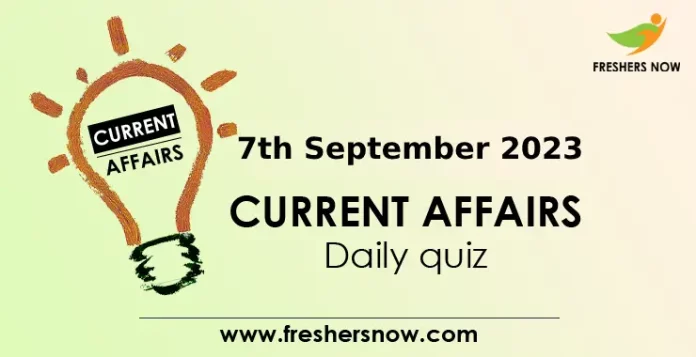
7th September 2023 Current Affairs Quiz: Welcome to the 7th September 2023 Current Affairs Quiz! In this quiz, we will test your knowledge of the latest and most significant events and developments that have taken place around the world on this particular day. Stay tuned as we present you with a series of questions designed to challenge your awareness of current affairs, politics, science, technology, and more. It’s a great way to stay informed and engaged with the world’s ever-evolving happenings. So, let’s dive in and see how well you’re up-to-date with the events of 7th September 2023!
7th September 2023 Current Affairs | Today GK Quiz
1. What is the primary objective of the SimplySAVE Merchant SBI Card?
A) Providing long-term credit to MSMEs
B) Offering rewards and discounts to individual customers
C) Addressing short-term credit needs of MSME merchants
D) Enabling international transactions for corporate clients
Answer: C) Addressing short-term credit needs of MSME merchants
Explanation: The main purpose of the SimplySAVE Merchant SBI Card is to cater to the short-term credit requirements of micro, small, and medium enterprises (MSMEs).
2. Which network does the SimplySAVE Merchant SBI Card operate on, providing wider acceptance and accessibility?
A) Visa
B) Mastercard
C) RuPay
D) American Express
Answer: C) RuPay
Explanation: The SimplySAVE Merchant SBI Card operates on the RuPay network, offering wider acceptance and accessibility across various merchant outlets and online platforms.
3. What is the main focus of the collaboration between the Department of Biotechnology and Armed Forces Medical Services (AFMS)?
A) Promoting undergraduate medical education
B) Facilitating research collaborations and scientific cooperation
C) Developing DNA vaccines
D) Inaugurating the API chapter at AFMC, Pune
Answer: B) Facilitating research collaborations and scientific cooperation
Explanation: The aim of the collaboration between the Department of Biotechnology and AFMS is to facilitate research collaborations and promote scientific cooperation, including faculty exchange programs.
4. What significant achievement has India made under PM Modi’s leadership in the healthcare field?
A) Development of three DNA vaccines
B) Development of a nasal vaccine
C) Inauguration of the API chapter at AFMC, Pune
D) Promotion of undergraduate medical education
Answer: A) Development of three DNA vaccines
Explanation: India, under PM Modi’s leadership, achieved significant progress with the development of two DNA vaccines and one nasal vaccine in just two years.
5. What is the main advantage of India’s first UPI-ATM over traditional cardless cash withdrawals?
A) It requires a physical ATM card for transactions.
B) It relies on mobile numbers and OTPs for authentication.
C) It offers QR-based UPI cash withdrawals.
D) It allows cash withdrawals only from one bank account.
Answer: C) It offers QR-based UPI cash withdrawals.
Explanation: The UPI-ATM utilizes QR-based UPI cash withdrawals, which is a key feature differentiating it from traditional cardless cash withdrawals.
6. What is the transaction limit for cash withdrawals using the UPI-ATM?
A) ₹5,000 per transaction
B) ₹10,000 per transaction
C) ₹20,000 per transaction
D) No transaction limit
Answer: B) ₹10,000 per transaction
Explanation: The UPI-ATM has a transaction limit of up to ₹10,000 per transaction, which is aligned with existing UPI daily limits and issuer bank’s UPI-ATM transaction limits.
7. What is the primary objective of the Viability Gap Funding (VGF) scheme for Battery Energy Storage Systems (BESS) in India?
A) Enhancing the integration of coal-based energy into the grid
B) Promoting the use of non-renewable energy sources
C) Reducing the cost and improving the economic viability of energy storage
D) Providing funding for nuclear power plants
Answer: C) Reducing the cost and improving the economic viability of energy storage
Explanation: The primary objective of the scheme is to reduce the cost of battery storage systems and enhance their economic viability.
8. Who will be the beneficiaries of 85% of the BESS projects under this scheme?
A) Private sector entities
B) Public sector entities
C) Power distribution companies (discoms)
D) Renewable energy producers
Answer: C) Power distribution companies (discoms)
Explanation: 85% of the BESS projects under this scheme will be allocated to power distribution companies (discoms) to facilitate the integration of renewable energy into the electricity grid.
9. What is the primary environmental benefit of the solar city inaugurated in Sanchi, Madhya Pradesh?
A) Reducing annual carbon dioxide emissions
B) Increasing the energy needs for agriculture
C) Enhancing the city’s tourism industry
D) Promoting the use of coal and other resources
Answer: A) Reducing annual carbon dioxide emissions
Explanation: The solar city in Sanchi, Madhya Pradesh, will reduce annual carbon dioxide emissions by 13,747 tonnes, which is equivalent to more than 2,38,000 trees.
10. How will the solar city in Sanchi help in annual savings for the city?
A) It will reduce pollution in the city.
B) It will provide free electricity to all residents.
C) It will result in ₹ 7.68 crore annual savings on electricity expenditure.
D) It will generate revenue through tourism.
Answer: C) It will result in ₹ 7.68 crore annual savings on electricity expenditure.
Explanation: The solar city in Sanchi will help in an annual saving of ₹ 7.68 crores on electricity expenditure for the city.
★★ You Can Also Check ★★



